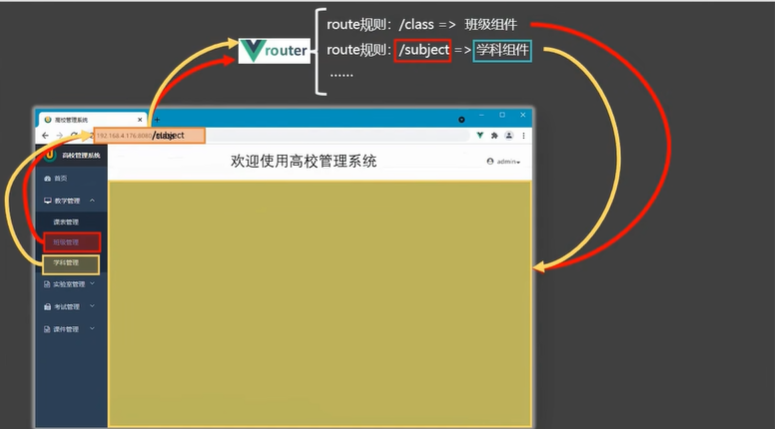vue-router路由
相关理解
- 生活的路由和路由器是为了完成多台设备上网。

-
开发编码里的路由和路由器是为了实现SPA应用的。
-
多页面应用
多个页面,点击内容不断跳转,在浏览器开新的页签。
-
单页面应用 SPA
导航区+展示区,只进行局部页面刷新,但是浏览器的路径会发生变化。
页面应用丰富,用户体验更好。
-

什么是路由?
-
路由就是一组映射关系,==key-value==。
-
key为路径,value可能是函数function或组件component 。
路由分类
- 前端路由
- 理解:value是组件,用于展示页面内容
- 工作过程:当浏览器路径改变时,对应的组件就会显示
- 后端路由
- 理解:value是函数,用于处理客户端的需求
- 工作过程:服务器接收到一个请求时,根据请求路径找到匹配的函数来处理请求,返回响应数据
vue-router
-
vue的一个插件库,专门用来实现SPA应用。
-
在vue2中,只能使用
vue-router3npm i vue-router@3
声明式路由跳转
基本使用
-
安装
vue-router -
写
router配置项:在router/index.js文件中 (分为4步)// 引入Vue import Vue from 'vue' // 引入VueRouter import VueRouter from 'vue-router' // 1.使用插件 Vue.use(VueRouter) // 2.引入组件 import About from '../components/About' import Home from '../components/Home' // 3.创建router实例对象,去管理一组一组的路由规则 const router = new VueRouter({ routes:[ { path:'/about', component:About }, { path:'/home', component:Home } ] }) // 4.暴露router export default router -
点击页面按钮实现切换(导航式跳转方式)
router-link标签最终会转换成a标签,不改变a标签的样式结构。router-link标签:将原来a标签的href属性变成to,然后路径写成/组件名的格式,无后缀<!-- Vue借助router-link标签实现浏览器路由的切换,用这个标签替换a标签 --> <router-link class="list-group-item" active-class="active" to="/about">About</router-link><a class="list-group-item active" href="./about.html">About</a> -
指定路由组件在页面中的展示位置
Vue借助router-view标签指定组件的呈现位置 <router-view></router-view>上述内容不发生浏览器请求,仅涉及前端显示内容的切换。
注意点
-
组件类型
-
组件分类
-
一般组件:定义、在
app.vue中引入、在vc中注册、在template中使用 -
路由组件:使用
router-link、router-view,无需在app中注册写组件
-
-
存放组件
-
一般组件和路由组件,会把他们放在不同的文件夹下面。
-
pages存放路由组件,components存放一般组件
-
-
-
不用的路由组件是隐藏了还是销毁了?
-
通过切换,“隐藏”了的路由组件,默认是被销毁掉的,需要的时候再去挂载。
(但是不用再次发送网络请求)
-
验证:使用生命周期钩子beforedestroy可以验证
-
-
route和router
-
router路由器整个应用只有一个
router,可以通过组件的$router属性获取。 -
route路由规则每个组件都有自己得
route属性;里面存储组件自己的路由信息,可以通过组件的
$route属性获取。
-
<router-link>的replace属性
-
作用:控制路由跳转时操作浏览器历史记录的模式
-
浏览器历史记录有两种方式
浏览器使用一个栈保存访问国的历史记录
push在栈顶追加历史记录replace替换栈顶的历史记录
声明式(导航式)路由跳转默认使用
push追加模式
-
-
实现:开启替换
replace模型<router-link replace .......>News</router-link>用户在页面上点击
News,地址栏显示跳转到的路由,页面内容显示路由对应的组件
嵌套(多级)路由
-
实现:
-
配置路由规则时,使用
children配置项:routes:[ { path:'/about', component:About, }, { path:'/home', component:Home, // 通过children配置子级路由 children:[ { // 注意:子路由下不要写成/news path:'news', component:News, } ] } ] -
点击页面
router-link实现导航式跳转注意:路径要写全,从自己的父级路由下开始写
<router-link to="/home/news">News</router-link>在实际开发中,嵌套到4-5层就足够了,几乎不会达到6层。
-
路由传参
-
声明式路由导航的
to后的内容有两种写法:==字符串、对象形式==二者的情况基本是互相通用的
query参数
-
路由跳转时传递参数
<!-- 传递query参数,to的字符串写法 --> <router-link :to="/home/news?id=666&title=你好">点击跳转到news页面</router-link> <!-- 传递query参数,to的对象写法 --> <router-link :to="{ path:"/home/news", query:{ id:666, title:'你好' } }" >点击跳转到news页面</router-link> -
接受/使用参数
// 在to的path/name对应的组件中使用接受的数据 // 在vc中使用数据 this.$route.query.id this.$route.query.title // 在模板中使用数据 $route.query.id $route.query.title
params参数
-
params参数较特殊,是将参数写在路由规则的path中 -
实现:
-
router/index.js下配置路由,声明接受parmas参数{ path:'/home', component:Home, children:[ { path:'news', component:News }, { component:Message, children:[ { name:'xiangqing', // 使用占位符声明接收params参数 path:'detail/:id/:title', component:Detail } ] } ] -
传递参数:
声明式路由跳转的
to的写法依旧有==字符串、对象==两种写法。<!-- 跳转并携带params参数,to的字符串写法 --> <router-link :to="/home/message/detail/666/你好">跳转</router-link><!-- 跳转并携带params参数,to的对象写法 --> <router-link :to="{ // 注意:此处不能写path,只能写name! // 命名路由见下一节 name:'xiangqing', params:{ id:666, title:'你好' } }" >跳转</router-link>注意
路由携带params参数,若使用to的对象写法,则不能使用path配置项,必须使用name配置!
-
接受/使用参数
// 在to的path/name对应的组件中使用接受的数据 // 在vc中使用 this.$route.params.id this.$route.params.title // 在模板中使用 $route.params.id $route.params.title
-
路由的props配置
-
问题:
路由组件在模板中使用传递过来的参数时,需要使用
$route.params.xxx的写法,很复杂。有没有办法简化?
- 计算属性,不行,这个会让问题更复杂
- 路由组件的
props配置
-
作用:
让路由组件更方便的使用接受到参数。
注意:是接收方,改变的接收组件使用数据的方式,传递数据的y方法还是不变的;
注意:一般组件的
props配置作用,是用于接受来外部(父组件)传递给组件自己的数据。 -
实现方式:
-
修改
router/index.js文件的配置;这里有三种写法{ name:'xiangqing', // 如果是params对象,占位符依旧要保留 path:'detail/:id', component:Detail, // 1.props值为对象,该对象中所有的key-value的组合最终都会通过props传给Detail组件 // 特点:死数据 // props:{a:900} // 2.props为true,把路由收到的所有params参数通过props传给Detail组件 // 特点: 动态数据,但是只能获取params的参数 // props:true // 3.props值为函数,该函数返回的对象中每一组key-value都会通过props传给Detail组件 // 特点: 函数形式,动态数据,params和query参数均可以传递 props(route){ // 必须返回一个对象 // key:传递的参数名 // value:传递的参数值;query和params参数均可 return { id:route.query.id, title:route.query.title } } } -
修改路由组件的配置,添加
props配置项<scrpit> export default{ name:'Detail', props:['id','titel'] // 注意带有’‘ } </scrpit>
-
命名路由
-
作用:简化路由跳转,只需要直接写要跳转的路由组件的名字即可(==注意是对象形式==),而无需写完整路径
-
实现:
-
给路由命名
routes:[ { path:'/about', component:About, }, { path:'/home', component:Home, children:[ { path:'news', component:News, name:'welcome' } ] } ] -
简化跳转
<!--简化前,需要写完整的路径 --> <router-link to="/about/home/news">跳转到news</router-link><!--简化后,直接通过名字跳转 --> <router-link to="{name:'welcome'}">跳转到news</router-link>
-
编程式路由导航
-
作用:使用
JS实现编程式路由跳转;不借助<router-link>标签的方式实现路由跳转,让路由跳转更加灵活。
-
实现
调用
$router提供的API实现编程式路由跳转// 跳转到指定路由组件 this.$router.push() // 跳转到指定路由组件,它不会向 history 添加新记录 this.$router.replace() // 前进 this.$router.forward() // 后退 this.$router.back() // 可前进也可后退 this.$router.go()this.$router.push({name:'welcome'}) this.$router.push({name:'welcome', params:{userID:'123456'}}) this.$router.push({ path: 'register', query: { plan: 'private' }})
缓存路由组件
-
作用:让不展示的路由组件保持挂载,不被销毁。(不会项浏览器发送请求)
-
实现:
<keep-alive include="News"> <router-view></router-view> </keep-alive>
路由守卫
-
作用:对路由进行权限控制。
如有一些内容需要登录才能看。
-
分类:全局路由守卫、独享路由守卫、组件内路由守卫。
全局路由守卫
全局路由守卫有全局前置路由守卫、全局后置路由守卫。
配置在router/index.js文件中
//全局前置守卫:初始化时执行、每次路由切换前执行
router.beforeEach((to,from,next)=>{
console.log('beforeEach',to,from)
if(to.meta.isAuth){ //判断当前路由是否需要进行权限控制
if(localStorage.getItem('school') === 'atguigu'){ //权限控制的具体规则
next() //放行
}else{
alert('暂无权限查看')
// next({name:'guanyu'})
}
}else{
next() //放行
}
})
//全局后置守卫:初始化时执行、每次路由切换后执行
router.afterEach((to,from)=>{
console.log('afterEach',to,from)
if(to.meta.title){
document.title = to.meta.title //修改网页的title
}else{
document.title = 'vue_test'
}
})
-
问题:
全局前置路由守卫一旦配置了,那是否这么多个路由规则需要一个一个写
to.xxx然后判断吗? -
解决方法:
-
在
router/index.js的路由规则中配置meta路由元信息 -
meta:{isAuth:true}通过该属性筛选出需要校验的路由规则,简化
to.xxx的判断,比如 判断to.name或to.path等于什么可通过配置统一变成:
to.meth.isAuth
-
独享路由守卫
配置在router/index.js文件中的特定的路由规则下
// 独享路由守卫只有前置没有后置
beforeEnter(to,from,next){
console.log('beforeEnter',to,from)
if(to.meta.isAuth){ //判断当前路由是否需要进行权限控制
if(localStorage.getItem('school') === 'atguigu'){
next()
}else{
alert('暂无权限查看')
// next({name:'guanyu'})
}
}else{
next()
}
}
// 该方法和上面的方法写法相同
beforeEnter: (to, from, next) => {
// 逻辑和全局前置守卫的逻辑一样
if (to.meta.isAuth) {
if (JSON.parse(localStorage.getItem('school')) === 'atguigu') {
next()
} else {
alert('学校名不对,不与通过!')
}
} else {
// 其他页面全部允许访问,不做任何限制
next()
}
}
组件内路由守卫
注意
只有通过路由规则进入该组件时,才会进行守卫。
<About/> // 通过标签的方式显示组件,不会执行组件路由守卫
配置在每个组件文件中,和data平级
//进入守卫:通过路由规则,进入该组件时被调用
beforeRouteEnter (to, from, next) {
// to必定是自己
},
//离开守卫:通过路由规则,离开该组件时被调用
beforeRouteLeave (to, from, next) {
// from必定是自己
}
路由器的两种工作模式
-
hash工作模式:-
对于一个url来说,
#号及其后面的内容就是hash值。hash值不会包含在HTTP请求中,即:
hash值不会带给服务器,因此hash模式部署到浏览器不会发生刷新报错的问题。 -
默认工作方式,地址中永远有个井号
#,不美观。 -
若以上将地址通过第三方收集app分享,若app校验严格,则地址会被标记为不合法。
-
兼容性较好。
-
-
history工作模式:-
地址干净,美观。
-
兼容性和
hash模型相比略差。 -
应用部署上线时,刷新会有404的问题,需要后端人员支持解决这个问题。
# 使用 connect-history-api-fallback 包 npm i connect-history-api-fallback其他方法:
nginx
-
-
项目上线:
-
打包项目
前端写完所有的代码,需要把这些项目打包得到最纯正的html、css、js文件,再部署到服务器上;不然客户的浏览器无法解析开发人员的
vue等文件。# 在写好的Vue项目文件夹中执行,打包项目 npm run build -
部署到服务器
将打包得到的
dist目录下的内容复制粘贴到后端项目的static/public(二者其一)的文件夹下。
-